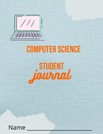
This CS Student Journal uses Essential Questions from the CS SOL Curriculum Framework for Grade 5.
- Subject:
- Computer Science
- English
- Impacts of Computing
- Writing
- Material Type:
- Homework/Assignment
- Author:
- Tara Williams
- Date Added:
- 06/08/2022

This CS Student Journal uses Essential Questions from the CS SOL Curriculum Framework for Grade 5.

This slideshow can be used as a lesson starter about how computers have influenced changes at home. It could be utilized as a whole class activity or as an individual assignment.

Video Description: Engineering design and technology development support scientific discovery. Learn about the roles engineers and scientists play when working together on NASA missions like the James Webb Space Telescope and how science and engineering take turns pushing each other to move exploration forward. Video Length: 4:16.NASA eClipsTM is a suite of online student-centered, standards-based resources that support instruction by increasing STEM literacy in formal and nonformal settings. These free digital and downloadable resources inform and engage students through NASA-inspired, real-world connections.NASA eClips Launchpad videos focus on NASA innovations and the technology that take us into the future. These segments support project-based and problem-based learning experiences in science, mathematics, and career and technical education classrooms.

Video Description: Each of us is made from star stuff. But how are stars formed? Take a closer look at the life cycles of stars and learn where stars come from, how they change, and what happens to stars when their lives come to an end. Find out about your connection to the cosmos. Video Length: 6:00.NASA eClipsTM is a suite of online student-centered, standards-based resources that support instruction by increasing STEM literacy in formal and nonformal settings. These free digital and downloadable resources inform and engage students through NASA-inspired, real-world connections.NASA eClips Launchpad videos focus on NASA innovations and the technology that take us into the future. These segments support project-based and problem-based learning experiences in science, mathematics, and career and technical education classrooms.

This matching activity reinforces students' recognition of how computing has changed our lives.